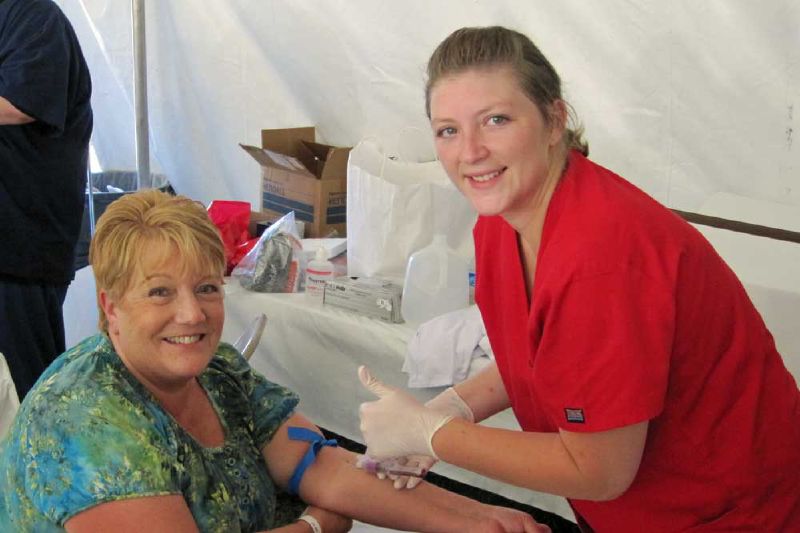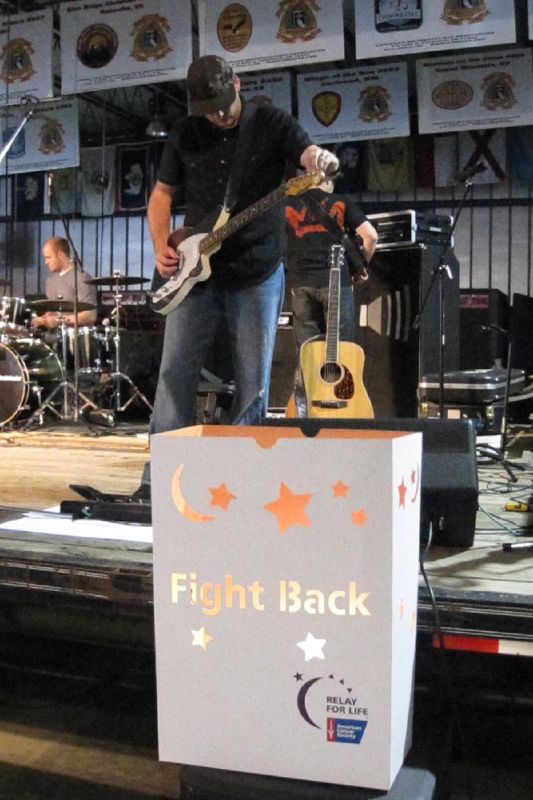
Friday afternoon Gina and I traveled to Hot spring to attend the Garland County Relay For Life which is the largest Relay in Arkansas. They have over 60 teams with over 730 participants. Even though we were interested in seeing a Relay of that size, the main reason that we attended was so that we could sign up for CPS-3.
CPS-3 stands for Cancer Prevention Study 3. The American Cancer Society first began conducting long-term studies in the 1950s. For these studies, large groups of individuals were recruited through a successful partnership between the American Cancer Society researchers and volunteers. The study population provides information (e.g. lifestyle, medical, or behavioral) and then are followed over time to assess their health outcomes and to determine how those outcomes are related to the previously collected exposure data. The commitment of the study participants and the volunteers who recruited them has been vital to the success of these studies.
Past long-term American Cancer Society follow-up studies have played a major role in cancer prevention at the American Cancer Society, as well as in other national and international efforts. More than 300 scientific articles by American Cancer Society epidemiologists have been published from these studies and findings have significantly contributed to tobacco-related research, and to the understanding of obesity, diet, physical activity, hormone use, air pollution, and various other exposures in relation to cancer and other diseases.
Results from previous American Cancer Society long-term follow-up studies have demonstrated:
* The link between cigarette smoking and lung cancer
* The significant impact of being overweight or obese on risk of cancer occurrence and death
* The impact of hormones, physical activity, diet, various medications and vitamins, and various other factors in relation to cancer risk
* The impact of air pollution on cardiopulmonary conditions motivating the Environmental Protection Agency to propose more stringent limits on particulate air pollution
* the link between aspirin use and reduced risk of colon cancer
* the link between postmenopausal hormone replacement therapy and various gynecologic cancers (such as breast and ovarian cancer)
* the link between diabetes and cancers of the pancreas and colon
* the link between physical activity and lower risk of various cancers (including breast, colon, and aggressive prostate cancer)
American Cancer Society researchers will be studying CPS-3 members for the next 20 to 30 years. The CPS-3 study population will have environmental and lifestyle exposures that may be meaningfully different from previous study populations and will help further advance understanding of the factors that cause or prevent cancer.
Gina and I were proud to be part of such a study. To enroll takes about twenty to thirty minutes. Enrollment consists of filling out a questionnaire that asks a number of lifestyle and medical questions. After filling out the questionnaire medical professional drew four vials of blood from you. Gina was very calm as her blood was drawn.
Actually those drawing the blood were extremely good. I have an extreme aversion to needles, but the girl who drew my blood did such a good job that I barely noticed. I just looked away and the deed was done. The most painful part for me was removing the tape that was placed over the insertion point. Having blood drawn was a small price to pay for being a part of such an important study. 
CPS-3 researchers need a blood sample to measure things such as hormones, nutrients, vitamins, chemicals, metals, and genetic factors that may be related to the risk of developing cancer. Questionnaire data provides a detailed picture of the participants lifestyle and environment, but the most accurate picture of actual exposures or susceptibility to disease may come from what can be measured in the blood. It is important to collect the blood sample when the participant is first enrolled in the study so that a new health problem does not alter the levels of anything that is measured.
After signing up for the CPS-3 study we stayed for a look around the Relay For Life that was going on. The Garland County Relay is held at the Oaklawn Jockey Club, one of the premier horse racing venues in the South. The event is big! Even getting parked is a time consuming process. The track for the Relay team members to walk on is so big that it doesn't seem like there are that many participants. We enjoyed being there but it just wasn't the same as our smaller hometown Relay where we know most of the people. 
The Survivor Lap was really something to see with that many Survivors lined up in one place to take a lap honoring them. We were a bit disappointed that they weren't given purple survivor t-shirts. The sea of purple shirts would have been awesome.
If you are near a CPS-3 sign up location I would recommend that you become involved in this important study. Click here to see if there is a location near you.
Sunday, May 23, 2010
Cancer Prevention Study - 3
Posted by Richard Lawry at 2:20 PM 0 comments
Wednesday, May 5, 2010
Relay Provides Time To Celebrate, Remember

This is an article from the April 29, 2010 edition of The Mena Star written by Andy Philpot
RELAY PROVIDES TIME TO CELEBRATE, REMEMBER
For three consecutive years, the Relay For Life has been on Mena's spring schedule through the organization of Regina and Richie Lawry, as well as a collection of devoted volunteers that have given the residents of Mena an opportunity to celebrate. This is no ordinary celebration though, as it is a chance to celebrate the victories of life, as well as the lives once close to us.
The fact remains that there is currently no cure for cancer, but through the American Cancer society, efforts are continually being made towards defeating the disease, and according to Regina Lawry, to have a day where no one will have to hear the words "you have cancer". Relay For Life has become an annual event in Mena that not only gives locals an opportunity to celebrate, but also to raise funds toward the ongoing battle against cancer as a cure is sought out.
Cancer touches so many of our lives, whether directly, or in the form of having a friend, family member, or loved one who has battled the condition. Relay For Life is organized to give those who have claimed victory against the disease a chance to showcase they are a survivor, as well as recognize the importance of the caregivers who are so crucial in the battle as well.
In the months leading up to the Relay celebration, teams are formed throughout the community to raise funds in a variety of ways, which all go to the American Cancer Society in efforts of reaching a cure. Teams range from businesses across town, to churches, to schools, to organizations, all working toward the same goal of continuing the fight against cancer. The response has been overwhelming over the past three years, with totals this year exceeding $48,000 raised for the American Cancer Society.
As the yearly event kicks off with its welcome from organizer Regina Lawry, the Survivor Walk is truly an inspiration, as local cancer survivors all sporting their purple shirts take laps to showcase their victory over cancer, and the collection of people are your friends, family, and co-workers. The survivor lap is accentuated with smiling faces both of those walking, and those witnessing a sight of celebration of another year of life.
With musical performances throughout the night, the environment is that of a party, but while there is time to celebrate, there is also a time to remember those who we have lost to cancer. Leading up to the Relay event, luminary bags are purchased, each in honor of someone who has either battled cancer, or has been lost to the disease. When the lights are dimmed, and the candles are aglow within the named luminary bags, the names of all the loved ones are read to remember, honor , and celebrate their life as well.
The luminaries each represent a life, and all have a story within them. While they represent the light of that person's life, it also glows throughout the night to represent the hope that continues that one day there will be a cure for cancer.
The Relay celebration is an all night event that lasts until 10:00 A.M. the following morning, in representation that "cancer never sleeps", and throughout the night, team members can be seen walking laps until the break of dawn.
Last years Relay event, which was scheduled for late April, was postponed due to the tornado and the damage in Janssen Park, but was held in late May. This year's event was relocated to the CMA facility at Iron mountain due to the rainy weather conditions, but the atmosphere was powerful, and the strong support shown by the community was evident by the numbers in attendance, and certainly with the total funds raised.
Relay For Life dates back to May of 1985 when Dr. Gordon Klatt wanted to raise money for the American Cancer Society in honor of his patients, and walked a track for 24 hours, and throughout the night, friends paid $25 to run or walk 30 minutes with him. He walked approximately 83 miles and raised $27,000 to fight cancer. The following year the first official Relay For Life event was organized, and now the event has grown to include nearly four million people over 5,000 communities across the United States.
Posted by Richard Lawry at 6:22 AM 0 comments




